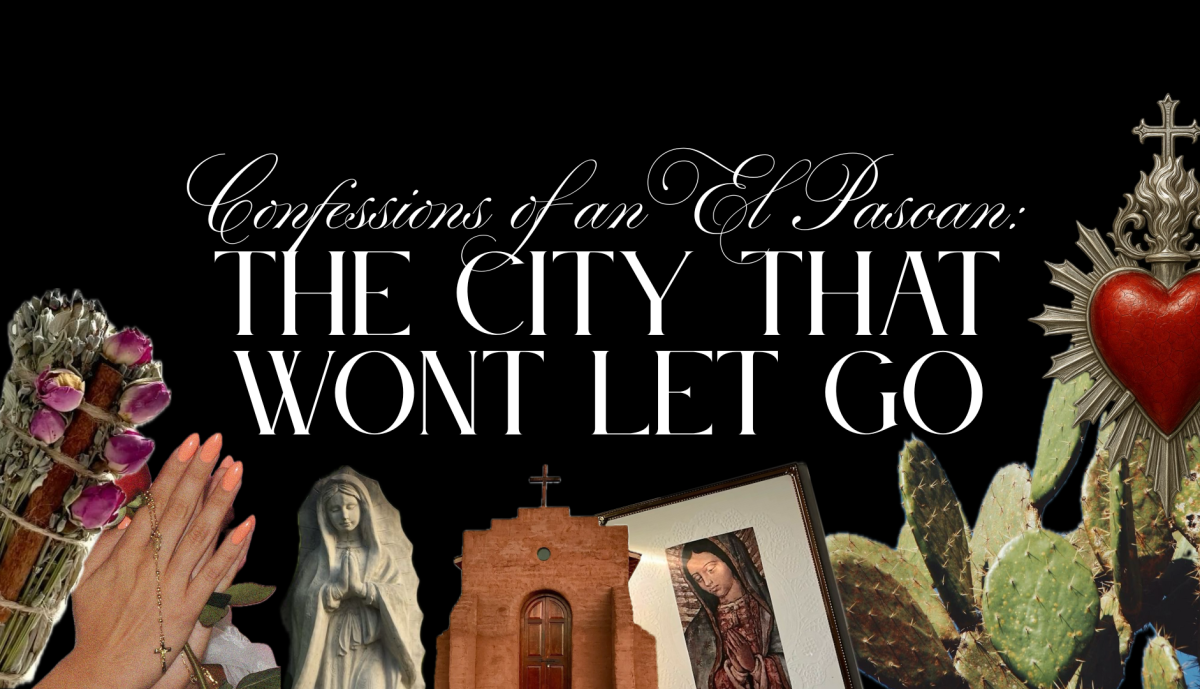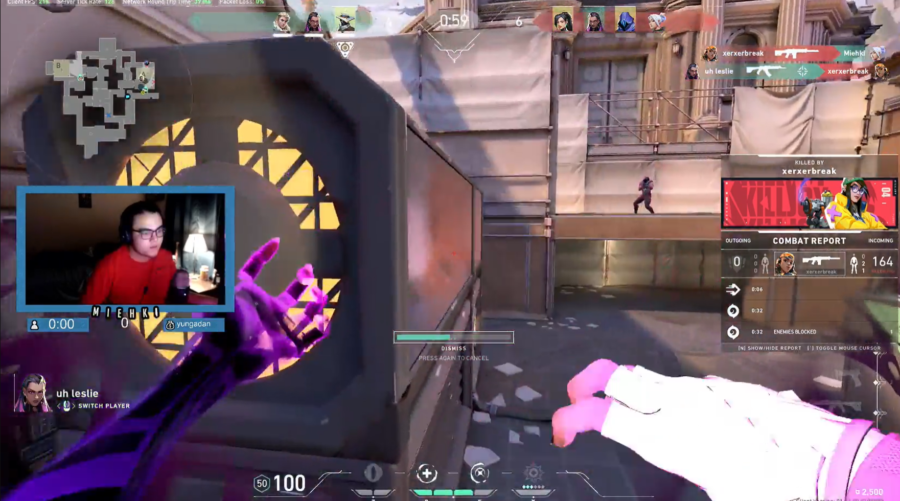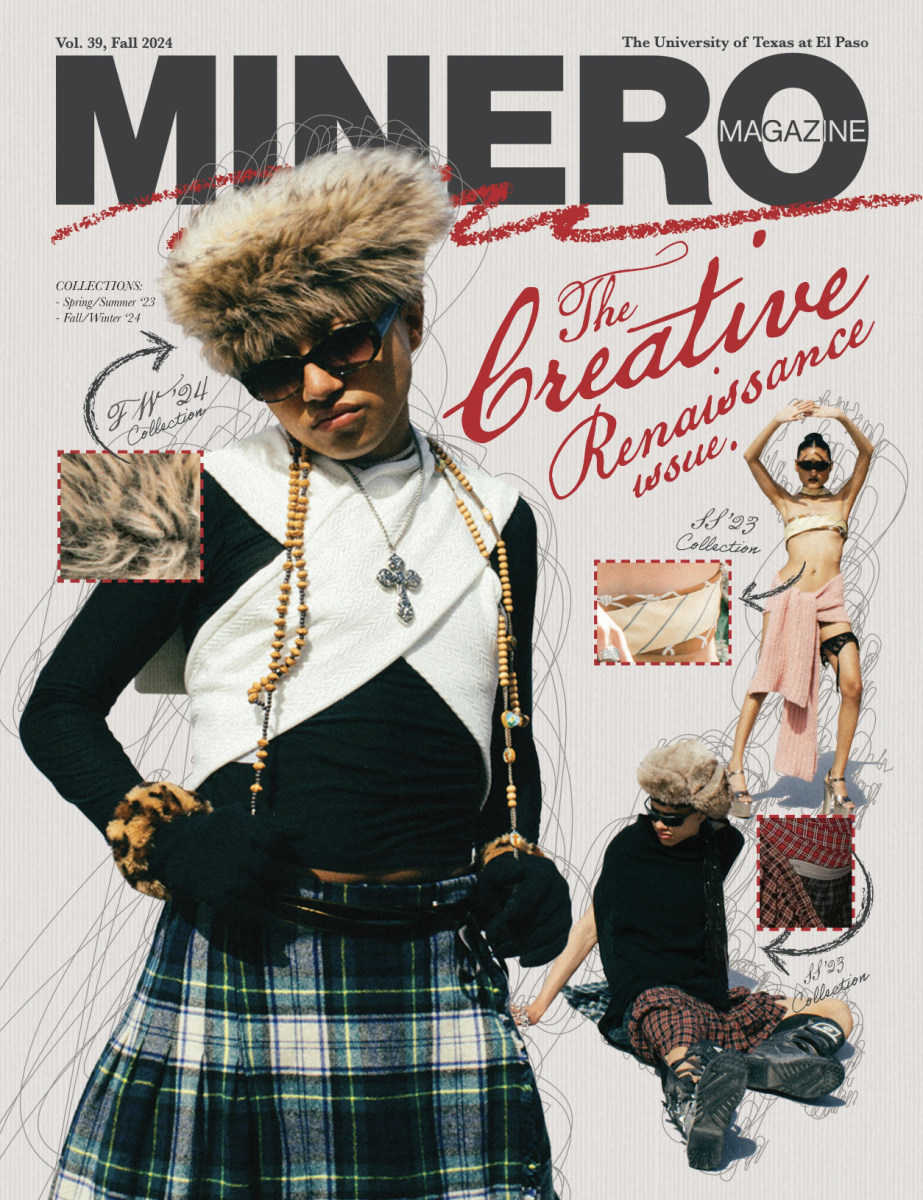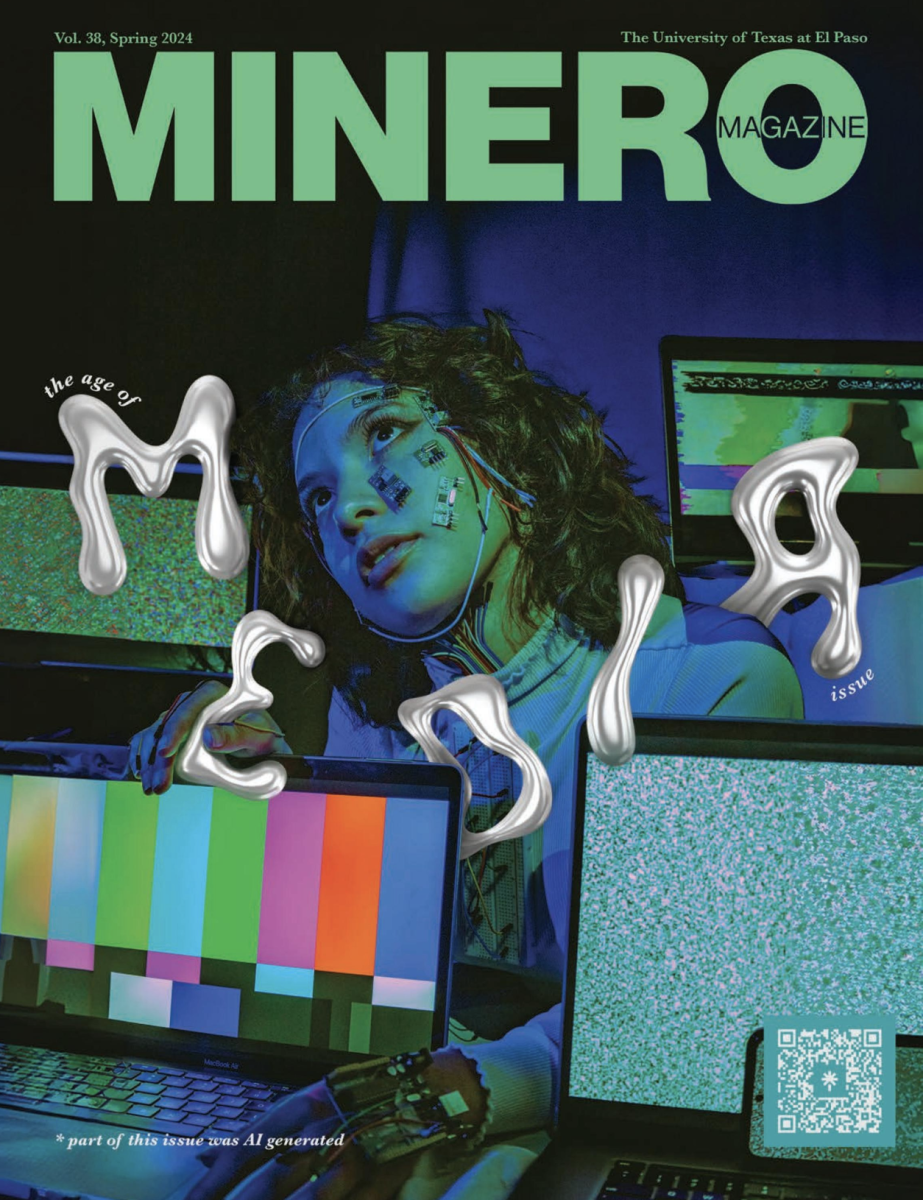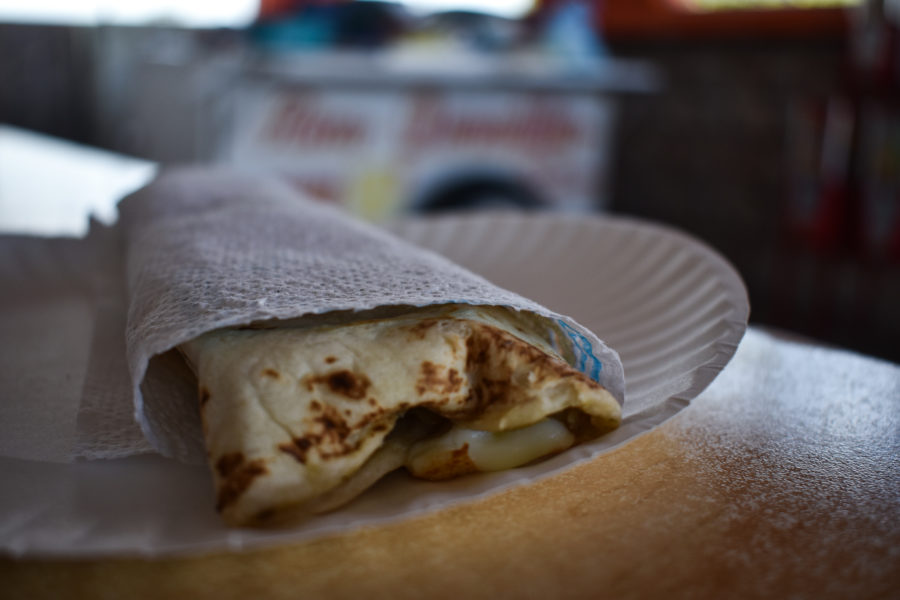Burritos on the Border: What makes a burrito?
January 24, 2020
What makes a burrito?
The warmth of the folded flour tortilla seeped into the skin on his fingertips. Like a marshmallow, any tiny bit of pressure created a small u-shaped dent on the edges. Manuel Rodriguez, a native El Pasoan for over 18 years moved to San Antonio in the year of 2018 and now attends St. Mary’s University. He consumed the meal slowly, in a way that kept him on the edge of his seat— it never led him to assume that he would lose his tooth.
“I was probably around 4 or 5 when it happened,” Rodriguez says. “I was going through that time where you start losing teeth and it just so happened that biting into a burrito would make it finally fall out.”
The burrito Rodriguez described was small – less than half an arm’s length. He recalled his mother making multiple sets of burritos and packing them in containers for his father who worked in construction.
“I’ve moved now and here they call it something else. They’re called breakfast tacos here in San Antonio,” said Rodriguez.
“He needed to eat lunch and the easiest way to give him a good meal was for my mom to make him a burrito. She’d put beans sometimes, maybe beef, anything really and then it got to the point where she started making them for everyone that my dad worked with,” Rodriguez says.
The list goes on: beans, cheese, lettuce, avocado, and even rice—the amount of ingredients that a burrito can encompass is limitless. Burritos are often associated in America with big name restaurants such as Chipotle: Mexican Grill, which specializes in tacos and Mission-style burritos. It’s simple to make and simple to order: pick your choice of meat or beans or rice, roll it up inside of a flour tortilla and fold it at the ends. Whereas in Mexico, in places like Juarez, or even the border city of El Paso the burrito may be associated with more close-to-home restaurants like Burritos Crisostomo.
“We know that burritos were invented in Juarez back in the day when they were laying down the train tracks. They would send a donkey with a basket on each side and they were trying to make tacos bigger. The substitution of a corn tortilla proved to not be very elastic, so they switched corn to flour,” said manager and owner Luis Padilla of local Burritos Crisostomo restaurants.
Traditionally, he says, burritos are made with a hand rolled tortilla on the spot, “always.” Then, refried beans and a guisado. A guisado, which roughly translates to stew, is typically homemade with a combination of ingredients involved.
“There’s a big difference between a guisado and a single ingredient” said Padilla. “When you go to Chipotle, you’re getting ingredients inside your burrito. That’s a plain carne asada, a plain barbacoa, a plain chicken burrito. It’s just that one ingredient inside your flour tortilla.”
Burritos Crisostomo first opened its doors in 1979 under the name: Burrito de Oro (Golden Burrito). The business which started in Ciudad Juarez, then expanded after selling more than 1,000 burritos during opening weekend.
“We grew up with burritos. The first thing that I remembered when we were very young was that dad would take us to one of the shops and he would sit me and my brother on the counter and he would let us pick what we wanted to put inside of our tortilla and we would always pick the weenie, the hot dog. I have really good memories of going to our own shop when it started,” said Padilla.
But, according to America’s first Taco Editor, just because it looks like a burrito doesn’t mean you call it one.
Recently, The New Yorker, an American magazine whose topics vary from politics to music and food, published an article about America’s first Taco Editor: José R. Ralat, because he made a claim that a burrito isn’t a burrito, it’s just a taco. The statement brought attention to the topic of Tex-Mex cuisine and in the article titled America’s First Taco Editor Says That Burritos Are Actually Tacos, Ralat speaks about how he classifies burritos as tacos.
“I was reading up reference material that was available in Spanish and the Spanish language books cataloged burritos or what they called ‘burritas’ as tacos. It wasn’t me, I just happened to agree with these people who have been doing this a lot longer than I have,” Ralat says.
“They explain that, yes, burritos are large, folded tortillas, but they are still tacos,” said Ralat in The New Yorker article.
To understand Ralat’s reasoning, we must first understand the history of the burrito and its ingredients. The first appearance of the word “burrito” in America appeared in the Los Angeles Times in 1958. Since then, the burrito’s presence in America has been most noticeable in chain restaurants like Chipotle, yet the origins of the warmly wrapped culprit seem to be lost in history.
Some may be able to recall events like the flight of the NASA Discovery space shuttle, but, not many know of astronaut Danny Olivas. Olivas, who was raised in El Paso, was asked on the morning of Sept. 8th, 2019 to make the Discovery crew breakfast burritos. Olivas and his fellow crew member Jose Hernandez came together and put together the folded meals for the crew, but, this was not the first time that a burrito orbited the Earth in the Space Station. Olivas had put together a large batch on his previous mission two years before. In fact, according to Gustavo Arellano’s Taco USA: How Mexican Food Conquered America, a historical recollection of Mexican food throughout history, NASA had used tortillas for astronauts as early as 1985, when Rodolfo Neri Vela, a Mexican scientist, requested a pack as a part of his food provisions to make tacos. The tortilla itself is a versatile staple in Mexican food being used for burritos, tacos, enchiladas, flautas, and so much more.
To make a burrito, it begins with the staple ingredient: tortillas. The first appearances of tortilla recipes were seen scattered throughout American cookbooks in the 1890s, mostly written down by non-Mexicans as according Arellano’s Tacos USA. But, it wasn’t until 1899 when the first ever masa-mill was opened in America and after that moment according to Arellano, “The American tortilla industry changed.” Food items like Fritos, chain restaurants like Taco Bell, and companies like Disney soon after began to adopt the meal and adapted and morphed it into whatever they wished.
The exact timeline of the upbringing of the burrito is hard to pinpoint but, according to some theories posted in an online article by Vox titled How the Burrito Conquered, it was created some time in the 19th century as the word was recorded in Mexican dictionaries during that time. The burrito itself has been nationally available since the 1960s and according to Arellano, they have existed in the borderlands since the 1920s. No one truly knows why or who invented the burrito but, in the Vox article about burritos, some theories are listed:
- The Sonora Theory: Sonora, a North-Western Mexican state, holds a theory that the people from Sonora invented the burrito because it was easy to travel with. The diminutive of burrito is burro, or donkey, leading some researchers to believe that the full name: ‘burrito’ is derivative from the idea that the name may have come about from its role as a sidekick to the donkey.
- The Chihuahua Theory: a story rooted in 1910 Chihuahua during the Mexican revolution depicts a man named Juan Méndez who wrapped his food in a flour tortilla. He then proceeded to take the wrapped concoction with him on his small donkey.
- The Ciudad Juárez Theory: in the 1940s, a street vendor portioned food to serve schoolchildren and in the process the word ‘burritos’ was formed and used as a way to call the kids dimwitted.
In the 20th century, burritos began to appear in the United States due to mass populations of Mexican citizens migrating to the U.S. for the Bracero Program. Migrant workers and farm laborers in the 1940s would be handed burritos in masse as it was an easy meal to make. According to Taco USA, most braceros weren’t familiar with burritos and it quickly became an object of scorn. The folded flour tortillas given contained only beans and occasionally cheese given in pairs to each person for their lunch. Mexican students from the 1950s to the 1960s were shamed by their peers for consuming the lunch item at school. Nonetheless, Americans eventually grew to love the burrito and the folded delicacy found a home in Southern California.
It quickly became popular and the meal itself became a staple in Los Angeles’s catering truck scene in the 1950s. Okinawan immigrant Sakai “Jimmy” Sueyoshi created the “Oki-Dog”: two hot dogs, chili, cheddar cheese, pastrami, and grilled onions wrapped in a flour tortilla and grilled them to serve to hungry youth from a hot-dog stand.
This led way to the invention of the Mission-styles burrito: salsa, corn, meat and an unnumbered amount of other ingredients encompassed in a large flour tortilla. By 1990, according to John Roehmer’s Cylindrical God, more than a hundred Latino restaurants opened almost all of them serving burritos. The popularity of the food item expanded and reached as far as the white house.
Former President Richard Nixon brought popular Mexican cuisines to the White House after the 1960 election as reported in G. Scott Thomas’s biography: A New World To Be Won: John Kennedy, Richard Nixon, and the Tumultuous Year of 1960. Burritos then began to make their move on the fast food industry.
The introduction of the Mission burrito to non-Mexicans didn’t bloom until the late 1980s, when Arellano describes that a new wave of “young, mostly white professionals” moved into the barrios of San Francisco. One of these young immigrants being the founder of Chipotle Steve Ells.
The birth of Chipotle Mexican Grill in 1993 solely relied on the burrito and had quick rise due to its popularity, yet, the franchise held humble beginnings. According to Taco USA, Ells’s first burrito was from a Denver street-burrito vender, but a moment in which he still remembers is a day when visiting the Mission to try its famous burritos for the first time.
“I unwrapped it completely from the foil, and my friend said, ‘No, no- wrap it back up,” said Ells quoted from Arellano’s Taco USA.
“For me, forever, a burrito was from a plate and smothered in green chile. This was something completely different. It was delicious. And I started to eat them often,” said Ells.
According to the Vox article, since its creation, Chipotle has grown to have more than 1,700 locations.
“People love Mexican foods because they’re craving exciting flavors,” said Ells.
Overall, the burrito has a long history rooted in Mexican culture but, the question still stands: does the burrito qualify as a taco?
Ralat, whose online blog Taco Trail highlights the different variations of tacos throughout Texas, describes how a taco takes different shapes, sizes, and forms, making the term versatile in use.
“In Mexico City, Tacos al Pastor generally come rolled. Not everyone does it, but it’s not unusual. I was in Brownsville in February and I had some Tacos al Pastor, tiny little thing, rolled, and it had waxpaper around it so it looked like sushi and at the Brownsville supermarket they serve Super Tacos filled with barbacoa with flour tortillas, rolled and sealed on both ends and they are an arm’s length. The terms are interchangeable,” said Ralat.
Yet, in cities along the border such as El Paso or even Ciudad Juarez the individuality of a taco exists separately from the burrito. In fact, Alberto Albama, a Villa Ahumada business owner and burrito maker, stands by the argument that tacos are their own dish. But, he states a much different story of the origins of the burrito.
Aldama has been working at the Villa Ahumada stop for over 20 years making burritos and quesadillas for whoever stops by. Villa Ahumada, a town 77 miles from Ciudad Juarez has been making asadero for centuries.
“Many times many people from Colorado and California come and they’ve waited to come to Villa Ahumada to eat burritos and eat quesadillas, it’s the tradition,” said Aldama.
The business, which according to Aldama, started off small. A few people with some coolers, Villa Ahumada’s most famous cheese and some warm tortillas in boxes on the side is what started it all.
“Everything here first started with the cheese,” said Aldama. “When the trains would come by, we would sell them asadero and tortillas separately. Then, as more time passed people started to ask for them inside the tortillas and it turned into more.”

So, as tradition goes, when you ask for a burrito, you’ll be sure to get some asadero inside. This Villa Ahumada traditional meal may seem more closely related to the definition of a quesadilla: cheese inside of a tortilla and heated. Yet, its wrapped structure and openness to be filled with whatever a customer likes on the inside is what makes it fall underneath the burrito category.
“A typical burger? A patty and ketchup and a bun. People want something different today. They want more. There’s something really great about the burrito in that people can make all different types of combinations of things. I can’t imagine people going down the service line and making chile relleno. It doesn’t quite lend itself- same with the tamale. They’re delicious- I love them, they’re wonderful, but they’re something different. There is something great about burritos- because they’re customizable,” said Ells.
Burritos en la frontera
Qué es lo que hace a un burrito?
Lo caliente de una tortilla de harina doblada se siente en la piel de sus dedos. Como un bombón, cualquier presión chica crea un agujero en las orillas. Manuel Rodriguez, un nativo de El Paso por más de 18 años antes de cambiarse a San Antonio en el 2018 y quien también pertenece la Universidad de St. Marys, consumía su comida lentamente, de una manera que lo tenía en la orilla de su asiento–nunca lo llevó a asumir que perdería su diente.
“Probablemente tenía como cuatro o cinco años cuando pasó”, dice Rodriguez. “Estaba pasando por ese tiempo cuando se te empiezan a caer los dientes y luego solo pasó que en una mordida en un burrito por fin se caería”.
El burrito que Rodriguez describe era chico–menos del largo de la mitad de un brazo. Él recordaba a su mamá haciendo varios burritos y empaquetándolos para su papá quien trabajaba en construcción.
“Me moví a San Antonio y aquí les dicen algo más. Les llaman tacos de desayuno aquí en San Antonio”, Rodriguez dice. “Él necesitaba algo para almorzar y la manera más fácil para que él tuviera buena comida era que mi mamá le hiciera un burrito. Ella les ponía frijoles a veces, tal vez carne, realmente de todo y luego llegó al punto de que ella empezó a hacerlos para todos los compañeros de mi papá,” Rodriguez dice.
La lista sigue: frijoles, queso, lechuga, aguacate, y hasta arroz. La cantidad de ingredientes que un burrito puede contener no tiene límites. Los burritos son frecuentemente asociados en los Estados Unidos con cadenas de restaurantes como Chipotle: Mexican Grill, la cual se especializa en tacos y burritos al estilo de Misión (Mission style burritos). Es simple preparar y ordenar un burrito- escoges tu proteína- carne o frijoles, o arroz, lo envuelven en una tortilla de harina y la doblan en las puntas.
“Sabemos que los burritos fueron inventados en Juárez cuando estaban poniendo las vías del tren. Mandaban un burro con una canasta colgando de cada lado y luego estaban intentando hacer tacos más grandes. La sustitución de una tortilla de maíz probó no ser tan elástica, entonces cambiaron de tortilla de maíz a tortilla de harina”, dice el gerente y dueño de los restaurantes locales Burritos Crisostomo, Luis Padilla.
Tradicionalmente, Padilla dice, los burritos son hechos a mano con una tortilla envuelta ahí mismo, “siempre”. Luego, frijoles refritos y un guisado, que es típicamente hecho en casa con una combinación de ingredientes.
“Hay una gran diferencia entre un guisado y un solo ingrediente”, Padilla dice. “Cuando vas a Chipotle, te están dando ingredientes dentro de tu burrito. Eso es una carne asada plana, una simple barbacoa, un burrito de pollo. Es solo ese ingrediente dentro de tu tortilla de harina”.
Burritos Crisostomo abrió sus puertas por primera vez en 1979 bajo el nombre de Burritos de Oro. El negocio, que empezó en Ciudad Juárez, luego expandió después de vender más de 1,000 burritos en el primer fin de semana.
“Crecimos con burritos. Lo primero que me acuerdo de cuando éramos niños era que mi padre nos llevaba a una de las tienditas y me sentaba con mi hermano en el mostrador y nos dejaba escoger lo que queríamos dentro de nuestra tortilla y siempre escogíamos weenie. Tengo recuerdos muy lindos de ir a nuestra propia tienda cuando empezamos”, Padilla dice.
Pero, según el editor de America’s First Taco, José R. Ralat, solo porque parece ser un burrito no significa que puedas llamarle así. Recientemente, The New Yorker, un revista estadounidense cuyos temas varían de política y música a la comida, publicó un artículo donde Ralat clasifica a los burritos como tacos, argumentando que realmente no son comidas diferentes.
“Estaba leyendo materiales de referencia que estaban disponibles en español y los libros en español catalogaron burritos o lo que les llamaban -burritas- como tacos. No fui yo, solo sucede que concuerdo con estas personas que han estado haciendo esto por mucho más tiempo que yo”, Ralat dice. “Ellos explican que, sí, los burritos son tortillas grandes y dobladas, pero todavía son considerados tacos”.
Para entender la lógica de Ralat, primero tenemos que entender la historia del burrito y sus ingredientes. La palabra “burrito” apareció por la primera vez en los Estados Unidos en un artículo del periódico Los Angeles Times en 1958. Desde entonces, la presencia del burrito en los Estados Unidos ha sido más perceptible en restaurantes de cadena como Chipotle, pero los orígenes del caliente y envuelto inmaculado parece estar perdido en la historia.
Algunos podrán recordar los eventos recientes como el vuelo del transbordador NASA Discovery, pero muchos no saben del astronauta Danny Olivas, quien creció en El Paso y se le pidió en la mañana del 8 de septiembre del 2019 preparar unos burritos de desayuno para el equipo del Discovery. Olivas y su compañero Jose Hernandez se juntaron y cocinaron las comidas dobladas para el equipo, pero, esta no fue la primera vez que un burrito orbitara fuera del Planeta Tierra.
Olivas había preparado una tanda grande de burritos en su misión anterior de dos años antes. De hecho, según el artículo “Taco USA- Cómo la comida mexicana conquistó América” de Gustavo Arellano, que es una recolección histórica de comida mexicana a través de la historia, la NASA había usado tortillas para astronautas desde 1985, cuando Rodolfo Neri Vela, un científico mexicano, pidió un paquete de tortillas como parte de sus provisiones de comida para hacerse tacos.
La tortilla misma es una comida es un símbolo versátil en la comida mexicana, la cual es usada para burritos, tacos, enchiladas, flautas, y mucho más.
Para hacer un burrito, se empieza con el ingrediente esencial: tortillas. Las primeras apariciones de recetas para tortillas fueron dispersadas entre los libros de recetas estadounidenses de los 1890s, con la mayoría siendo escritas por personas que no eran mexicanas, según Arellano. Pero, no fue hasta 1899 cuando el primer molino de masa se inauguró en los Estados Unidos y después de eso, según Arellano, “la industria estadounidense tortillera cambió radicalmente”. Comidas como Fritos, cadenas de restaurantes como Taco Bell, y compañías como Disney prontamente empezaron a adoptar la comida y la adaptaron en lo que ellos querían.
La fecha exacta de la popularización del burrito es difícil de encontrar. Pero, según unas teorías en un artículo de Vox con el título “Cómo el burrito conquistó”, la comida fue creada en algún momento del siglo XIX ya que la palabra “burrito” no fue inventada en diccionarios mexicanos hasta ese entonces. El burrito en sí ha sido nacionalmente disponible desde los 1960s y según Arellano, han existido en la frontera desde los 1920s. Nadie sabe por qué o quién inventó el burrito, pero en el artículo por Vox se listan algunas teorías:
- La teoría de Sonora: Sonora, un estado en el noroeste de México, mantiene la teoría de que la gente de Sonora inventó el burrito porque era fácil de viajar con uno. El diminutivo de burrito es burro, haciendo a que algunos investigadores crean que el nombre completo, “burrito”, es una derivación de la idea de que el nombre tal vez pueda venir de su rol como asistente del burro.
- La teoría de Chihuahua: una historia del Chihuahua de 1910 durante la Revolución Mexicana representa a un hombre llamado Juan Méndez quien envolvió su comida en una tortilla de harina. Luego, él procedió a llevar la mezcla gastronómica envuelta con él sobre su burro chico.
- La teoría de Ciudad Juárez: En los 1940s, un vendedor ambulante proporcionaba comida para los niños que salían de la escuela y en el proceso, la palabra “burritos” fue formada y usada para llamar a los niños “tontos”..
En el siglo XX, los burritos empezaron a aparecer en los Estados Unidos gracias a una grande migración de poblaciones mexicanas a los Estados Unidos por el Programa Bracero. Desde trabajadores migrantes hasta granjeros en los 1940s, a todos se les dio burritos en masse porque era una manera más fácil de que todos comieran.
Según Arellano, la mayoría de los braceros no estaban familiarizados con los burritos y rápidamente los burritos se hicieron objeto de burla y desdén. Las tortillas de harina dobladas solo llevaban frijoles y ocasionalmente queso, el cual fue distribuido en par a cada persona para su almuerzo. También, los estudiantes mexicanos de los 1950s a los 1960s fueron avergonzados por sus compañeros por consumir los burritos en la escuela. Sin embargo, los estadounidenses eventualmente llegaron a amar el burrito y la delicadeza doblada encontró una casa en el sur de California.
El burrito se hizo rápidamente popular y la comida en sí se convirtió en un símbolo esencial de la escena de food trucks en Los Ángeles durante los 1950s. El inmigrante de Okinawa, Sakai “Jimmy” Sueyoshi, creó el “Oki-Dog”, o dos perros calientes con chili, queso amarillo, pastrami y cebollas a la parrilla envueltos en una tortilla de harina y parillados para servir a los jóvenes con hambre de un puesto de perros calientes.
Esto permitió la oportunidad para la invención de los burritos del estilo de Misión: salsa, elote, y varios otros ingredientes sin límites, todos revueltos en una gran tortilla de harina. Para 1990, según el artículo de John Roehmer “Dios Cilíndrico”, más de 100 restaurantes Latinos abrieron, con casi todos sirviendo burritos. La popularidad del burrito se extendió y ha llegado hasta la Casa Blanca.
El ex-presidente Richard Nixon trajo la gastronomía mexicana a la Casa Blanca después de las elecciones de 1960, según la biografía de G. Scott Thomas “Un Nuevo Mundo por Ser Ganado: John Kennedy, Richard Nixon, y el Año Tumultuoso de 1960”. Poco después, los burritos empezaron a hacer su escala a la industria de comida rápida.
La introducción del burrito al estilo Misión a los no-mexicanos no floreció hasta la conclusión de los 1980s, cuando Arellano describe a una nueva ola de “profesionales jóvenes, principalmente blancos” que se movieron a los barrios de San Francisco. Uno de estos inmigrantes fue el fundador de Chipotle, Steve Ells.
El nacimiento de Chipotle: Mexican Grill en 1993 sólo dependía del burrito y rápidamente incrementó su popularidad. Pero su franquicia tuvo orígenes humildes. Según Arellano, el primer burrito de Steve Ells fue de un vendedor ambulante de burritos en Denver, pero un momento el cual todavía recuerda resulta en un día cuando visitaba la Misión para probar los famosos burritos por la primera vez.
“Lo desenvolví completamente del aluminio, y mi amigo dijo, “no, no, envuélvelo” ,dice Ells en artículo Taco USA de Arellano.
“Para mí, siempre, un burrito era un platillo y lo embarré en chile verde. Esto fue algo completamente diferente. Fue delicioso. Y empecé a comérmelos muy seguido”, Ells dice.
Según el artículo de Vox, desde su creación, Chipotle ha crecido hasta tener más de 1,700 locaciones.
“La gente ama la comida mexicana porque tienen antojo de sabores emocionantes”, Ells dice.
Generalmente, el burrito tiene una historia larga y arraigada en la cultura mexicana pero, la pregunta sigue siendo, el burrito califica como un taco?
Ralat, cuyo blog en línea Taco Trail subraya las diferentes variaciones de tacos por todo Texas, describe como un taco toma diferentes formas y tamaños, haciendo que el término sea versátil en uso.
“En la Ciudad de México, los tacos al pastor generalmente vienen enrollados. No todos lo hacen, pero no es fuera de lo común. Estaba en Brownsville en febrero y comí unos tacos al pastor, unas cositas chiquitas, enrolladas, y tenían papel encerado alrededor entonces se veían como sushi y en el supermercado en Brownsville sirvieron Super Tacos, llenos de barbacoa con tortillas de harina, enrollados y con las puntas de la tortilla dobladas por ambos lados. Los términos son intercambiables”, Ralat dice.
Aún así, en ciudades como El Paso o Ciudad Juárez, la individualidad de un taco existe separada del burrito. De hecho, Alberto Aldama, un empresario de Villa Ahumada y quien hace burritos para vivir, sigue firme con el argumento de que tacos son su propio platillo diferente del burrito. Él afirma una historia muy diferente en cuestión de los orígenes del burrito.
Aldama ha estado trabajando en la parada de Villa Ahumada por más de 20 años haciendo burritos y quesadillas para todos los que visiten. Villa Ahumada, un pueblo a 77 millas de Ciudad Juárez, ha estado haciendo asadero por siglos.
“Muchas veces, mucha gente de Colorado y California vienen y han esperado venir a Villa Ahumada para comer burritos y comer quesadillas, es la tradición”, Aldama dice.
El negocio, según Aldama, empezó chico, con poca gente con hieleras, el queso más famoso de Villa Ahumada, y unas tortillas calientes en cajas al lado.
“Todo aquí al inicio empezó con el queso”, Aldama dice. “Cuando los trenes pasaban, les vendíamos asadero y tortillas separadas. Luego, con tiempo, la gente empezaba a pedir el asadero dentro de las tortillas y se convirtió en más”.

Entonces, como dice la tradición, cuando ordenas un burrito, es un hecho que te darán asadero dentro. Este platillo tradicional de Villa Ahumada tal vez parece ser más relacionado a la definición de una quesadilla: queso adentro de una tortilla y calentado. Pero su estructura envuelta y su capacidad para ser llenada con lo que quiera un cliente es lo que hace al platillo calificarse como burrito.
“Una hamburguesa típica? Una carne y ketchup y un pan. La gente quiere algo diferente ahora. Ellos quieren más. Hay algo muy especial sobre el burrito en que la gente puede hacer todo tipo de diferentes combinaciones de ingredientes. No me puedo imaginar gente en fila y haciendo chile relleno. No es exactamente lo mismo, igual con los tamales. Son deliciosos! Me encantan, son maravillosos, pero son algo diferente. Hay algo especial sobre los burritos porque pueden personalizarse”, Ells dice.








